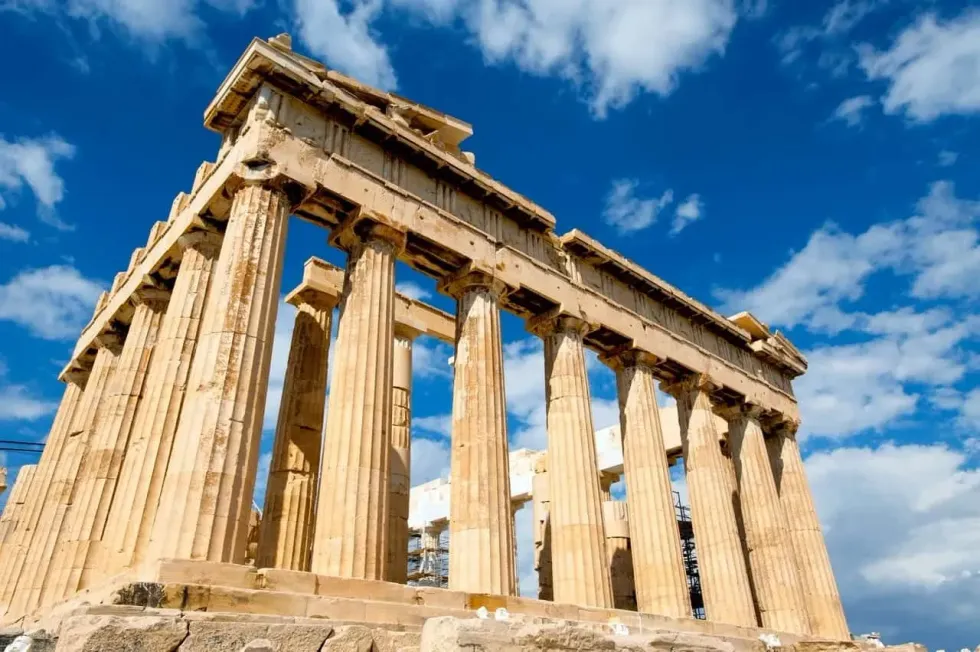Looking to brush up your knowledge of Ancient Greek mythology?
You'll likely have heard of Zeus, the king of all the Ancient Greek gods. But have you heard about the goddess Hestia?
Hestia was goddess of the hearth and goddess of the home, and Hestia's siblings were Zeus, Chiron, Poseidon, Hades, Demeter, and Hera. As with most Ancient Greek gods and goddesses, Hestia's early story is dramatic, but myths about Hestia are less well known than her famous siblings.
After reading this article, however, you'll be an expert on the goddess Hestia.
Don't forget to check out our Poseidon facts and Facts About Apollo, too.
The Mythology And Story Of Hestia
Learn about Hestia's place in Ancient Greek mythology, and why she rejected the marriage proposals of both Poseidon and Apollo.
1. Hestia was the eldest daughter of Cronus and Rhea, both of whom were Titans, and sister to Poseidon, Demeter, Hades, Hera, Chiron, and Zeus.
2. Hestia is considered one of the Twelve Olympian gods, but sometimes is swapped out for Dionysus, depending on the myth's author.
3. Her father Cronus swallowed all of his children: as Hestia was the first born, she was consumed first.
4. However, when Zeus fought back against his father, causing Cronus to spit his children back up again, Hestia was the last to emerge. Hestia myths, therefore, celebrate her as being both the oldest and youngest of her siblings.
5. Hestia joined her siblings' battle against Cronus and Rhea and the rest of the Titans, taking up her place at Mount Olympus as goddess of the hearth after defeating their parents.
6. Apollo and Poseidon wanted to marry Hestia, but she rejected both of them, swearing herself instead to remain a virgin goddess, like Athena and Artemis.
7. Hestia therefore never married and had no children.
8. Hestia's virginal status and her naturally calm, gentle nature, resulted in her being one of the lesser-known greek goddesses involved in fewer myths and stories.
9. As Hestia was the virgin goddess, she is frequently considered the opposite of Aphrodite, the Ancient Greek goddess of love.
10. Neither of Homer's works, The Iliad, and The Odyssey, mention Hestia, but poets such as Ovid do refer to her, and she is mentioned in Homeric Hymn 24 and 29.

Hestia's Symbol, Power And Picture
Do you know the Roman equivalent of the Greek goddess Hestia? Read on to learn about her characteristics and responsibilities.
11. Hestia is the Ancient Greek goddess of the hearth, home, and family.
12. Hestia's symbols are therefore the hearth, the fire, and the kettle.
13. The word 'Hestia' literally means 'hearth' in Greek, which is the floor of the fireplace.
14. The Roman name of Hestia, however, is Vesta.
15. Hestia's Roman equivalent had similar functions to the Greek goddess, as the embodiment of Rome's domestic and public hearths and families.
16. The Greek goddess Hestia typically lives on Mount Olympus, home of the Greek gods, but can also be found at Delphi.
17. Hestia was responsible for maintaining the hearth and fire of Mount Olympus. The fire was used for cooking the fatty portions of animal sacrifices that were made to the gods, and keeping the home of the gods warm.
18. Hestia also taught people how to build a home, and helped to keep family peace.
19. As goddess of hearth and home, Hestia also personified the fire burning in every Greek household.
20. She represented communal security and family, and her dominion was domestic life.
21. The goddess is characterised as forgiving and kind, and the most gentle and mild of all the gods.
22. Hestia's peace-loving nature also resulted in her occasionally being characterised as mild or cold, which were sometimes considered weaknesses.
23. As a result of her non-confrontational nature, Hestia is typically pictured as a modest woman, usually wearing a veil and robe, holding a flowered branch to symbolise peace, and sometimes by a large fire.
24. There is a Byzantine tapestry called the Hestia Tapestry which was made in Egypt in the 6th century AD. It shows Hestia goddess of hearth and home as a fruitful, generous figure, with a headdress and earrings made of pomegranates.

The Cult Of Hestia
Learn about how Hestia was worshipped at the public hearth.
25. Although Hestia the goddess is less famous than her siblings, both public and private worship of her was common.
26. Ancient Greek people could worship Hestia at any temple, regardless of which god to which the temple was dedicated.
27. Hestia herself had very few temples dedicated to her, but there were two at Sparta and Ermioni.
28. However, every private and public hearth was considered Hestia's sanctuary.
29. Every city also had a public hearth that was Hestia's sacred space: the fire was never allowed to go out.
30. Equally, if a family accidentally extinguished their domestic hearth fire, this represented a failure of religious and domestic care.
31. If the hearth fire was deliberately extinguished, it had to be done in ritual only, and it had to be re-lit with rituals of purification, renewal, and completion.
32. When a new colony was established, Hestia's fire would be taken from the hearth in the prytaneion (the town hall) and carried to the new city to light its hearths.
33. Hestia received the first offering of every sacrifice made in the home - often families poured sweet wine in her name and gave her the richest portion of food.
34. It is also understood that Hestia's mythical status as the firstborn of Rhea and Cronus resulted in the tradition of Hestia being given the first offering of any sacrifice.
35. Children were also accepted into a family by being presented at Hestia's hearth, ensuring the blessing of the goddess.
Here at Kidadl, we have carefully created lots of interesting family-friendly facts for everyone to enjoy! If you liked our suggestions for facts about Hestia, then why not take a look at Chichen Itza facts, or Zodiac facts.










